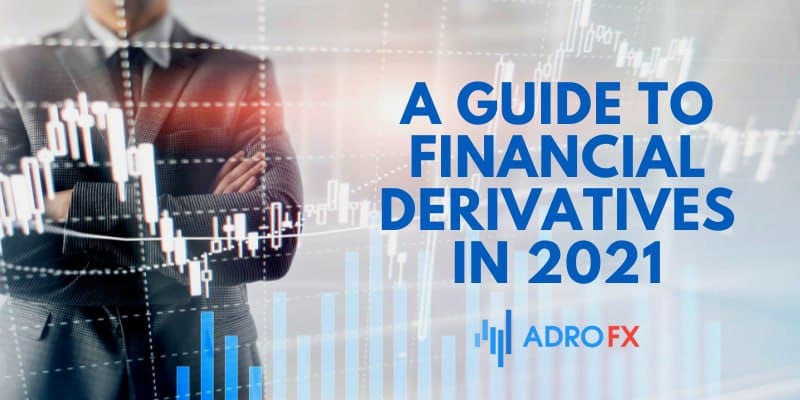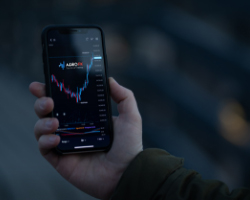A Guide To Financial Derivatives in 2021

Among the wide range of financial instruments, traders often face difficulties when choosing a suitable asset for trading. If you are also wondering what to start with, we recommend you pay attention to derivatives.
While derivatives trading is inherently simple, many novices struggle with some issues. To avoid such problems, we will go into the details of financial derivatives, including their types and advantages.
What are Financial Derivatives?
A derivative is a contract between two or more parties whose value is based on a derivative underlying financial asset (such as security) or set of assets (such as an index). Common underlying instruments include bonds, commodities, currencies, interest rates, market indices, stocks, or cryptocurrencies.
Simply put, a derivative is a financial asset whose value depends on an underlying asset or group of assets.
The derivative itself is a contract between two or more parties, and the price of the derivative is determined by fluctuations in the underlying asset.
Why Use Derivatives?
Making use of derivatives entails a lot of advantages, including hedging, speculation, and leverage.
Hedging
Hedging means insurance against losses. This strategy entails a reduction of unfavorable factors for the seller or the buyer. It is especially relevant for companies working with foreign firms-suppliers because with deferred payment there is a risk of unfavorable exchange rate fluctuations. Suppliers of volatile goods, such as agricultural produce, metal, oil, and petroleum products are also involved in hedging.
In this strategy, a contract with a negative yield correlation is signed on the futures market. Under this condition, upward or downward price changes will bring sellers and buyers winning and losing at the same time in different markets.
Hedging is the ability to lock in a price at a future point in time. Futures can be sold at a premium or a discount, which means you can hedge your positions and get a gain on the size of the basis minus the costs. The financial result with this will be equal when the value of the underlying assets rises or falls.
With options, the amount hedged depends on the premium at the selected price. Options are less costly and do not carry much risk. But it is better to use futures if you are sure about future market conditions.
Forwards and swaps are the most effective way to hedge basis risks. They are flexible concerning the circumstances in which the contract is signed and allow you to include the desired terms in the transaction. The difficulty with such derivatives is finding counterparties when the liquidity of derivatives is low.
When hedging, over-the-counter futures to buy and sell various assets are made. The index difference may be delivered by both parties or by one of them.
Swaps are used for currency, interest, and commodity hedging. Commodity swaps help to fix the purchase and sale price for the buyer and the seller, respectively, over a long period. The purpose of hedging is to remove uncertainty in future cash flows.
Speculation
Speculation refers to trade to obtain a premium, which is made up of the difference in the market value of a financial instrument. The participants of this strategy are speculators. They are an important guarantor of the market liquidity and are ready to undertake the risks of the operation.
The environment of the derivatives market is typical for speculation because in such circumstances there are many opportunities, which the leverage mechanism provides. It is possible to open a position on the futures exchange market by depositing a margin or premium. Derivatives allow market participants to play for larger amounts than, for example, an investor.
If we evaluate the risk-reward ratio, it should be noted: the growth of risk is proportional to an increase in the potential profit. When the market begins to move in the opposite direction, the speculator runs the risk of incurring large losses.
Arbitrage

Arbitrage means gaining profit, which can be fixed, by playing opposite positions on the underlying asset on different exchange markets. The derivative nature of the financial instruments market makes such transactions possible. The difference in the value of the underlying asset on the derivatives market at one time makes it possible to conduct an arbitrage transaction.
Derivatives are successfully applied in the formation of the innovative financial product, implemented by financial engineering in different spheres of the economy. Thanks to derivative financial instruments, the modern market has gained considerable opportunities for risk hedging, speculative and arbitrage transactions, as well as for the introduction of an innovative product. The development of the field of derivatives contributes to the improvement of financial market subjects' activity.
Leverage
Another important argument to use derivatives is leverage. It allows the trader to make transactions for amounts many times greater than his own funds. In addition, leverage allows beginners to try themselves in real trading with a minimum amount of risky investments.
Leverage is a ratio of an investor's traded contract volume to his own investments. The value of leverage is determined by the agreement between the trader and the broker and maybe 1:1, where the trader refuses to use borrowed funds, as well as 1:100, 200, and even 1:500 or 1:1000.
The most common variations of leverage in trading are: 1:50; 1:100; 1:200.
For those beginners who opened a $1000 trading deposit without using leverage (1:1), it is unlikely that they will receive a significant income in online trading. The standard leverage of 1:100 allows the trader to operate the sum of $100,000 when investing his own thousand dollars in trading.
If everything is clear with the profit for the player, then why does the broker need to help the average trader to earn money? The financial benefit of the company lies in the provision of long-term credit, which is a good advertising "trick" and helps to attract more clients for the service.
Beginner traders should remember that trading with the use of leverage has both advantages and disadvantages.
As noted above, the first advantage of working with leverage is the ability to operate with large sums of money. A dealing center gives a trader its own money as if in debt or management. Having a small amount at his disposal, the player expects to get a good profit from trading on Forex, using the leveraged capital. This prospect of profit is what attracts most traders.
Another advantage of trading with the use of leverage is the fact that traders cannot lose more than the amount they have invested. For example, a trader using 1:100 leverage and investing $1,000 will incur losses of that $1,000 if he loses, but not more.
But disadvantages of the appliance of leverage resulting from its advantages are not widely publicized, though beginning traders must find out about this aspect first before they start trading. Trading and using high leverage, in case of insignificant market movements against positions a trader can find himself in a situation of margin call and lose most of his deposit.
Types of Financial Derivative Products
There are many different types of derivatives that can be used for risk management, speculation, and for position enhancement. Let us have a look at them.
Contracts For Difference (CFDs)
CFD or Contract for Difference is a financial instrument that enables you to profit from the price movements of an asset without having to own the asset itself. The nature of the contract is that the positive difference between the opening and closing prices of a particular financial asset is paid by the seller to the buyer and the negative difference by the buyer to the seller. The contract also specifies the time at which this difference is defined.
Understanding what CFDs are, we can conclude that CFDs are only for exchange-traded assets:
- currency;
- stocks;
- raw materials (oil, gas, sugar, coffee, etc.)
- metals;
- stock indices;
- cryptocurrencies.
It is difficult to understand by one definition what a CFD is, so it is simpler to provide an illustration. Let`s say a trader bought 1 CFD of mini-Dow Jones at 10,400 points and sold the contract at 10,700 points. Thus, the difference between the index opening and closing was 300 points. The trader's profit at $5 per contract was $5 * 300 = $15,00. If the index had not risen, and fallen by 300 points, the trader would have lost $ 1500 on this deal.
At first sight, it may seem that trading CFDs is not very different from usual currency pairs trading. Although a CFD is a mechanism for trading the underlying asset, the underlying asset itself is not involved in trading. That allows the trader not to work at the financial instrument market, but to derive the same financial result.
British brokers invented CFD, who decided to interest their clients in trading stocks without paying a special tax. Formally, a trade with CFD was not a trade with the share and was not subject to tax. Then CFD became an ideal instrument for those, who did not have an opportunity to enter the market, for example, due to lack of money.
The main advantage of CFD was a lower capital requirement. This reduction is achieved, as there is no need to pay taxes and commissions for delivery of goods, inclusion in the register of shareholders, as well as other fees, which are paid for trading stocks. In addition, CFD trading allows the use of leverage. By trading with financial leverage, you can significantly increase your initial capital, but such trading involves a lot of risks.
It is good news that most of the brokerage companies that offer CFD trading allow working with these contracts in the same terminal as the forex. It is very convenient because learning a new program is a waste of time while working with a familiar platform is more enjoyable and productive. Indeed, all of us are very accustomed to MetaTrader, and working on other platforms we often make technical mistakes, which harm the trading. Moreover, the wide range of markets for CFD trading allows trading both currencies and different stocks.
The main disadvantage that we noticed in almost all dealing centers was huge spreads for CFDs. Therefore, strategies based on small price changes are in most cases inapplicable to CFDs. Naturally, the spread reduces profits and increases losses. Thus, avoiding the commission, which is paid when trading stocks, you face high spreads. Also, CFD traders cannot be shareholders.
Futures Contracts
A futures is a type of derivative (sometimes called a "secondary") financial instrument. Essentially, a futures is an agreement to buy or sell a primary instrument with deferred settlement. The primary or underlying instrument may be a security, currency, or raw materials.
A futures is an exchange-traded commodity. The futures price varies depending on the market situation. The other parameters are standard. They are the delivery time, the number of goods in the lot, its quality or brand. Thus, the buyer and the seller of the futures undertake the obligation to fulfill the contract on the stipulated term. The value of the asset itself may change by that time on the market, but it cannot influence the terms of the deal.
Unlike primary securities, futures have no standardized form of issue. Futures are not securities, but an agreement between two parties, with the exchange being involved. The exchange, being the organizer of the trades, sets requirements for the contracts and makes it obligatory to follow the specifications.
The official document of the futures contract must state:
- its name;
- its abbreviation;
- the type of contract - a staged or settlement contract;
- the quantity of goods per contract (lot size);
- the date of the contract execution;
- price step.
A futures contract is a separate exchange-traded commodity. The value of the futures is not always equal to the price of its asset. In addition to the price of the underlying asset, the futures price is influenced by various forecasts and risks of changes in the subject of the contract.
Forward Contracts
Forward contracts, known simply as forwards, are similar to futures, but are not traded on an exchange; they are only over-the-counter.
When creating a forward contract, the buyer and seller can modify the terms, size, and compensation procedure for the derivative. Like OTC products, forward contracts carry a high degree of counterparty risk for both buyers and sellers.
Counterparty risk is a type of credit risk in the sense that a buyer or seller may not meet the duties described in the settlement.
If one party to the contract becomes bankrupt, the other party may not have recourse and might lose the value of its position.
Once a forward contract is created, the parties can compensate their position with other counterparties, which can increase potential counterparty risk as more traders become engaged in the same position.
Options
An option contract is like a futures contract in that it is an agreement between two parties to buy or sell an asset at a prearranged date at a certain price.
The main distinction between options and futures is that with an option, the buyer does not have to exercise his consent to buy or sell.
It is only an option, not an obligation; futures are obligations. As with futures, options can be used to hedge or speculate on the price of the underlying asset.
Assume that an investor holds 100 stocks at $50 a share, which they believe will rise in the future.
Nevertheless, this investor is worried about the possible risks and chooses to hedge the position with an option.
The investors can buy a put option that provides them the right to sell 100 shares of the underlying asset for $50 per share, recognized as the strike price, until a certain day in the future, known as the expiration date.
Suppose the value of the stock drops to $40 per share at expiration, and the buyer of the put option decides to exercise his option and sell the stock at the original exercise price of $50 per share.
If the put option cost the investor $200, the investor has lost only the value of the option because the strike price was the same as the stock price at the original purchase. Such a strategy is called a protective put because it hedges the downside risk of the stock.
Alternatively, suppose that the investor does not own the stock, which is currently worth $50 per share.
However, he believes that the stock will rise in value over the next month. That investor could buy a call option that gives him the right to buy the stock for $50 before or after the expiration date.
Let's assume that this call option was worth $200, and the stock rose $60 before expiration.
The buyer of the call option can now use his option and buy the stock at $60 per share at an exercise price of $50, which is an initial profit of $10 per share.
The call option represents 100 shares, so the actual profit is $1,000 minus the cost of the option - the premium and any brokerage fees.
In both examples, the sellers of the put option and the call option must honor their side of the contract if the buyer of the call or put option chooses to exercise the contract.
However, if the stock price exceeds the strike price at expiration, the put will be worthless, and the seller-exerciser of the option will receive a premium at expiration.
If the stock price is below the strike price at expiration, the call will be worthless, and the call-seller will keep the premium.
These options are known as American-style options, but their use and early exercise are rare.
Traditional Trading vs Derivatives

When you are a traditional trader, you buy or sell an underlying asset. You own it, and then you can sell it to another market participant.
If you are a derivative trader, you will not own shares of a company. Instead, you buy or sell a contract. This contract is negotiated between you and the CFD provider, for example. You speculate on the price of the underlying asset and try to predict its movement from when the CFD opens to when it closes.
While the trading itself is quite similar in both cases, there are some significant differences between the two. What are they?
The trader agrees with his broker to exchange the cash difference in price with the opening and closing price at which the contract is concluded.
Financial derivatives, like CFDs, are traded on margin, which means that the broker lends you money. It allows you to use additional leverage and thus open a larger position than the trader's capital.
Like in traditional trading, you can open either buy or sell trades. But in the case of sell trades, you are not required to provide the underlying asset.
Profits are subject to capital gains tax, but they are generally exempt from UK stamp duty of 0.5%.
The first thing better about derivative trading is the aforementioned leverage. You don't have to spend all of your capital to open many positions. Your derivative provider will only require you to give 5-10% of the real value of the underlying stock. This allows you to trade even 20 times what you put down in cash. Sometimes it will even be more than 20. That is an incredible opportunity to capitalize on price movements. Another advantage is that you don't have to wait for the money to come back into your account before you open your next trade. So if you see a good entry point, you can just do it because you still have money in your account. After all, you are spending less money per trade.
You can benefit not only when the price of the underlying asset goes up, but also when it goes down. The contract is calculated on the difference in price between when you open the position and when you close it. Thus, you can take advantage of a stock that you think is overvalued at no extra cost.
The strategies you can use when trading derivatives are much more advanced. There are many tactics that you can implement and make trading easier.
Last but not least trading derivatives gives you access to various international markets such as currency pairs, stocks, commodities, sectors, or indices.
Trading Platforms for Derivatives
The MT4 trading terminal is a universally recognized standard among derivatives trading platforms. It is used by almost all brokerage companies. This software provides a high level of security and advanced technology. Using MT4, you will be able to trade without worrying about the stability of this terminal.
What are the features of this platform? First of all, we should highlight the intuitive interface, which greatly facilitates the work with the terminal. Because of this, even a novice can quickly grasp the functionality and its key options. Another feature is that these trading platforms support all major world languages. Thus, a trader from any part of the world can quickly master MT4. In addition, the terminal provides the user with impressive opportunities for technical analysis. All the graphical elements necessary for this purpose are available in the platform's functionality. Using them is very easy and convenient. MetaTrader 4 does not require any powerful hardware. This terminal will run smoothly even on an older computer or laptop. The main thing is to have a stable connection to the Internet. The functionality of the platform includes options that allow controlling the account balance, trading history, and much more.
About AdroFx
Adrofx is an online CFD broker that offers tailored trading features, competitive conditions, and a robust WebTrader platform, Allpips. The AdroFx brand is aiming to deliver excellence which is evident in the services they provide.









